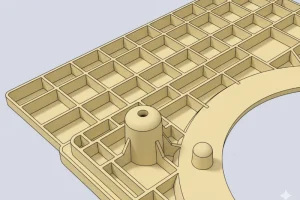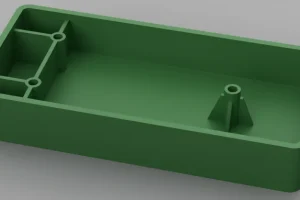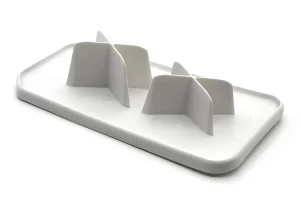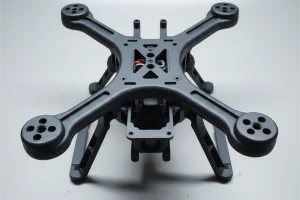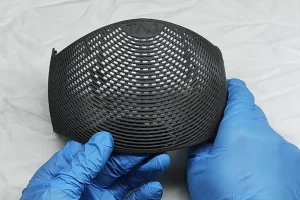Polyethylene (PE) is a thermoplastic resin made by polymerization of ethylene. It is insoluble in general solvents at room temperature, has low water absorption and excellent electrical insulation.
In industry, it also includes copolymers of ethylene and a small amount of α-olefin. Polyethylene is odorless, non-toxic, feels like wax, has excellent low temperature resistance (the lowest use temperature can reach -100 ~ -70 ° C), good chemical stability, can resist the erosion of most acids and bases (not resistant to acids with oxidizing properties).

Characteristics of PE material
Polyethylene is a typical thermoplastic, is odorless, tasteless, non-toxic flammable white powder. Forming and processing of PE resin are extruded and granulated waxy granular material, the appearance of milky white.
Its molecular weight is in the range of 10,000 to 1 million. The molecular weight over 100,000 is ultra-high molecular weight polyethylene f UHMWPE3.
The higher the molecular weight is, the better its physical and mechanical properties are, and the closer it is to the required level of engineering materials.
However, the higher the molecular weight, the more difficult it is to process. Polyethylene melting point is 100-130C-its low-temperature resistance is excellent. At -60 ℃ can still maintain good mechanical properties, but the use of temperature is 80 ~ 110 ℃.
Polyethylene chemical stability is good, at room temperature can be resistant to dilute nitric acid, dilute sulfuric acid and any concentration of hydrochloric acid, hydrofluoric acid, phosphoric acid, formic acid, acetic acid, ammonia, amines, hydrogen peroxide, sodium hydroxide, potassium hydroxide and other solutions.
However, it is not resistant to corrosion by strong oxidation, such as fuming sulfuric acid – concentrated nitric acid, chromic acid mixed with sulfuric acid.
At room temperature the above solvents have a slow erosive effect on polyethylene, while at 90-100°C concentrated sulfuric acid and concentrated nitric acid rapidly erode polyethylene and destroy or decompose it.
Polyethylene is subject to aging, discoloration, cracking, brittleness or chalking and loss of its mechanical properties under the action of atmosphere, sunlight and oxygen.
At the temperature of molding process, it also decreases its melt kill, discoloration and streaking due to oxidation, so it should be paid attention during injection molding process and use or material selection.

Types of PE materials
1. LDPE: low density polyethylene (also known as high pressure polyethylene)
2. LLDPE: linear low density polyethylene
3. MDPE: medium density polyethylene
4. HDPE: high density polyethylene (also known as low pressure polyethylene)
5. UHMWPE: Ultra High Molecular Weight Polyethylene
6. Modified polyethylene: chlorinated polyethylene (CPE), cross-linked polyethylene (PEX)
7. Ethylene copolymer: ethylene – propylene copolymer (plastic), EVA, ethylene – butene copolymer, ethylene – other olefins (such as octene POE, cyclic olefin) copolymer, ethylene – unsaturated ester copolymer (EAA, EMAA, EEA, EMA, EMMA, EMAH).
Polyethylene with a molecular weight of 3-6 million is called ultra-high molecular weight polyethylene (UHMWPE). The strength of UHMWPE is so high that it can be used for bulletproof vests.

Properties of PE material
Polyethylene has excellent chemical stability and is resistant to corrosion by various chemicals such as hydrochloric acid, hydrofluoric acid, phosphoric acid, formic acid, amines, sodium hydroxide, and potassium hydroxide at room temperature, but nitric acid and sulfuric acid have a strong destructive effect on polyethylene.
Polyethylene is easy to photo-oxidation, thermal oxidation, ozone decomposition, and easy to degradation under the action of ultraviolet light, carbon black has an excellent light-shielding effect on polyethylene.
After being exposed to radiation, cross-linking, chain-breaking, formation of unsaturated groups, and other reflections can occur.
It is a milky white, translucent thermoplastic made by the homopolymerization of ethylene and copolymerization with a small amount of α-olefin.
Density 0.86~0.96g/cm3, according to the density distinction, there is low-density polyethylene (also includes linear low-density polyethylene), ultra-low density polyethylene, etc.
Odorless and non-toxic. Chemical resistant, insoluble in solvents at room temperature. Low-temperature resistance, the minimum use temperature -70 ~ -100 ℃.
Good electrical insulation, and low water absorption. Physical and mechanical properties vary according to density.
Industrial low-density polyethylene mainly uses high-pressure (110-200MPa), and high-temperature (150-300 ℃) free radical polymerization.
Others use low-pressure coordination polymerization, sometimes the same set of devices can produce a density of 0.87 ~ 0.96g/cm3 polyethylene products, called full-density polyethylene process technology.
Polyethylene can be processed into films, wire and cable sheathing, pipes, various hollow products, injection molding products, fibers, etc.
It is widely used in agriculture, packaging, electronics, and electrical appliances. It is widely used in agriculture, packaging, electrical and electronics, machinery, automobiles, daily miscellaneous products, etc.

What are the process conditions of PE injection molding?
1. PE is a crystalline raw material with very little moisture absorption, not more than 0.01%, so no drying treatment is required before processing.
2. PE molecular chain is flexible, the inter-bonding force is small, the melt viscosity is low, and the fluidity is excellent, so the molding does not need too high injection molding pressure, it can be molded out of thin-walled long flow type parts.
3. PE shrinkage rate range, shrinkage value, directional obvious, LD PE shrinkage rate of 1.5% ~ 5.0%, HDPE in 25% ~ 60%, so easy to deformation warpage, mold cooling conditions on the shrinkage rate has a great impact, so the mold temperature should be controlled to maintain uniform and stable cooling.
4. PE’s crystallization ability is high, the temperature of the injection mold has a greater impact on the crystallization of plastic parts, high mold temperature, slow cooling of the melt, high crystallinity of plastic parts, high strength, it can be seen that the mold temperature has a great impact on the performance of plastic injection molded parts.
5.The melting point of PE is not high, but the specific heat capacity is larger, so the plasticization still needs to consume more heat, so the plasticizing device should be required to have a larger heating power to improve production efficiency.

6. PE softening temperature range is small, and the melt is easy to oxidation, for this reason, the PE injection molding process should be as far as possible to avoid contact between the melt and oxygen to avoid reducing the quality of plastic parts.
7. PE plastic parts made of soft texture, and easy to release, so when the plastic parts have a shallow side groove, you can make it strong to release the mold.
8. PE melt non-Newtonian is not obvious, shear rate changes (often by changing the molding pressure) on the viscosity of less, PE melt viscosity by the temperature is also less.
9. The cooling rate of PE melt is slow, so it must be fully cooled, the mold should have a good cooling system.
10. If PE melt in the injection using direct feed port feed, easy to increase the stress and produce uneven shrinkage and directional increase in deformation, so attention should be paid to the selection of feed port parameters.
11. PE has a wide range of molding temperature, and a little fluctuation of temperature in the flow state has no effect on injection molding.
12. The thermal stability of PE is good, generally there is no obvious decomposition phenomenon below 300℃, which has no effect on the quality.
13. Barrel temperature: the barrel temperature is mainly related to the density of PE and the size of the melt flow rate, and also related to the type and performance of the injection molding machine and the shape of the plastic parts.
Since PE is a crystalline polymer, the grains have to absorb certain heat when melting, so the barrel temperature should be 10℃ higher than its melting point. For LDPE, the barrel temperature control at 140 ~ 200 ℃, for HDPE can be controlled at 140 ~ 220 ℃, the rear of the barrel to take a small value, the front to take a large value.
14. Mold temperature: mold temperature has a greater impact on the crystallization of plastic parts, high mold temperature, slow cooling of the melt, high crystallization of plastic parts, high strength, but shrinkage will also increase. Usually the mold temperature of LDPE is controlled at 30~45℃, while HDPE is raised again 10~20℃ accordingly.

Application areas of PE materials
Using injection molding, blow molding, extrusion, rotational molding, and other molding methods, the production of film products, daily necessities, and industrial use of various sizes of hollow containers, tubes, packaging with calendering and ligature tape, rope, fishnet, and woven fibers, wire, and cable, etc.
Application films
LDPE is widely used as packaging material for various food, clothing, medicine, fertilizer, industrial products, and agricultural films. It can also be extruded and processed into composite films for packaging heavy items.
Since 1975, high-density polyethylene film has also been developed for its high strength, low-temperature resistance, moisture resistance, and good printability and processability.
In addition, polyethylene coatings can be extruded onto paper, aluminum foil, or other plastic films to make polymer composites.
Hollow products
High-density polyethylene with high strength, suitable for hollow products; such as milk bottles, and decontaminant bottles.

Pipe sheets
Extrusion method can produce polyethylene pipe, high-density polyethylene pipe strength, suitable for underground laying; extruded sheet can be secondary processing; also available foam extrusion and foam injection method of high-density polyethylene into low foam, for the table plate and construction materials; protective cover (such as cable sheathing).
Fibers
Fibers, also known as acetylene, are generally spun into synthetic fibers using low-pressure polyethylene as raw material.
It is mainly used in the production of fishing nets and ropes, or spun into staple fibers and used as wadding, but also for industrial acid and alkali resistant fabrics.
Super high-strength polyethylene fibers (strength up to 3-4GPa) have been developed and can be used as bulletproof undershirts, and composite materials for automobiles and marine operations.
Miscellaneous products
Miscellaneous products produced by injection molding include daily miscellaneous products, artificial flowers, crates, small containers, parts for bicycles and tractors, etc.; refrigerator containers, storage containers, household kitchenware, sealing caps, etc.; high-density polyethylene is used in the manufacture of structural parts.

Summary
This blog describes the types of engineering plastics PE, their properties and injection molding processes, the selection of equipment, product shape and mold design considerations, and solutions to common defects in actual production.
Because of these qualities, polyethylene is easy to process and mold, so its recycling is of great value. For the actual PE material selection and injection molding product production, it is recommended to choose an experienced injection molds supplier and injection molded factory to recommend a suitable PE material in terms of product usage and functional requirements, appearance, etc. to ensure the smooth implementation of the project.


